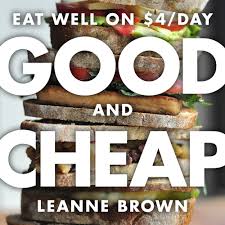Eating healthy doesn’t always require spending oodles of money at the whole foods market. You can eat healthy by being mindful when shopping. Using coupons at the grocery stores is a great way to save. You can also use your SNAP benefits at a majority of grocery stores and at farmer’s markets. Below are some great hints and tips for you to follow when planning a healthy menu at home and following a budget.
Menu planning
First thing I recommend is menu planning. Take one afternoon to sit down and come up with meals that you would be interested in making throughout the next week. A great tool to use is Leann Brown’s cookbook, “Good and Cheap”. She created this cookbook with the idea that a you can make a meal for less than $4 per day. I also build in left over nights at least 2 times a week so I am not wasting any food. If you have a family, cooking large recipes such as soups and casseroles can be helpful. You can even cook these for just two people and freeze half of it for another time. Keep in mind leftovers in the refrigerator are only good for about 24 hours so if you plan a leftover night, be sure that its leftovers from the night before and not 2 or 3 days previously.

Building a pantry
Another great tool is to build a pantry. Slowly start gathering key ingredients that can be used over and over again. Ingredients or food items like this include, flour, rice, pasta, canned vegetables, beans (canned or dried), broths, etc. Really you can use any food items that have a long shelf life. Building a pantry will create flexibility when grocery shopping. Instead of having to purchase all the ingredients for one recipe you may only have to purchase 2-4 ingredients and the rest are already in the pantry at home.
Buying in bulk
Buying in bulk is another method for saving money. It’s similar to building a pantry in that you can buy a large bag of rice and use it for a number of meals instead of buying a small bag of rice and using it for only one meal. Club memberships to Costco and Sam’s can be helpful because there you can buy in bulk for just about everything. If you have a large family to feed this is a great resource; they even take SNAP benefits or food stamps.
Buying seasonal
Buying seasonal is another good tip. Seasonal produce is more likely to be cheaper than other produce that has to be shipped into the areas. Great places to find seasonal produce is at your local farmer’s market. Some of the vendors there will take food stamps.

Gardening
If you are really enthusiastic, gardening is also another great resource. With the right education gardening can be a great way to save money, as well as, give you some physical activity during the day. It may be a little expensive to start up but once it’s up and going maintenance is a breeze. If you don’t have the time to have your own garden you can participate in a community garden, which are a part of many larger communities.
By: Emily Hamm, MS Candidate in Nutrition at UNCG
Resources